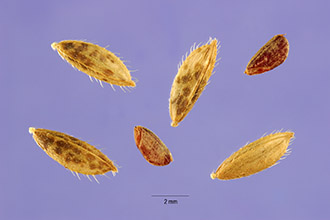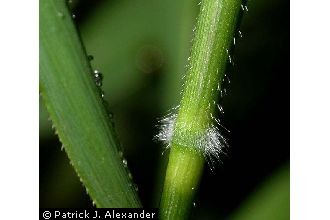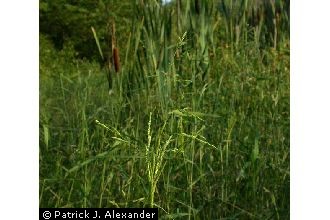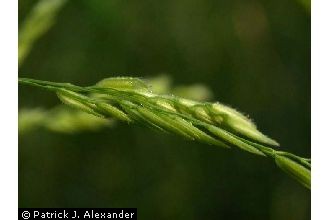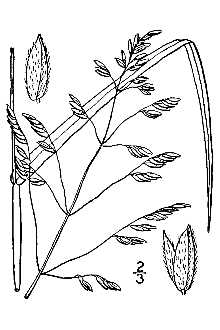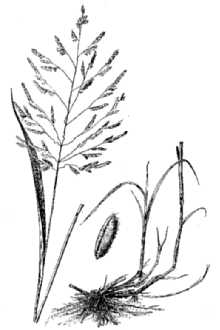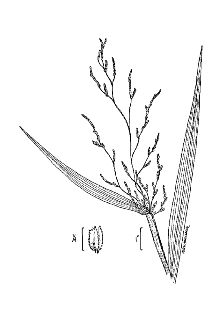Rice Cutgrass
Scientific Name: Leersia oryzoides (L.) Sw.
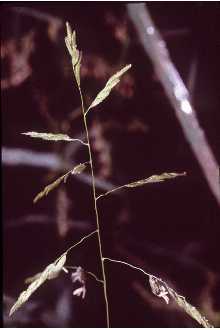
| General Information | |
|---|---|
| Usda Symbol | LEOR |
| Group | Monocot |
| Life Cycle | Perennial |
| Growth Habits | Graminoid |
| Native Locations | LEOR |
Plant Guide
Use soil moisture sensors to measure the soil moisture of Rice Cutgrass.
Fact Sheet
Alternate Names
Plant synonyms include Homalocenchrus oryzoides (L.) Pollich, and Phalaris oryzoides L. Another common name is sickle grass.
Uses
Rice cutgrass is valuable for wildlife habitat improvement, wetland restoration, and erosion control in ditches and other watercourses. The seeds are an important food source for waterfowl, small mammals, and shorebirds. Ducks pull up and consume underground stems (rhizomes). Dense colonies provide cover and habitat for fish, reptiles, and amphibians. The forage produced is highly palatable. This plant’s creeping rhizomes and spreading habit are good for sediment stabilization along the immediate shorelines of streams and lakes. Tolerant of highly acidic conditions (pH=3), the species is being studied for use in constructed wetlands and the treatment of acid mine drainage. It may have potential for vegetated drainage ditches that mitigate agricultural runoff, including pesticides.
Status
Please consult the PLANTS Web site and your State Department of Natural Resources for this plant’s current status (e.g. threatened or endangered species, state noxious status, and wetland indicator values). Dale Darris USDA NRCS Corvallis PMC
Description and Adaptation
Adaptation
Adaptation
Rice cutgrass is a native cool season grass that grows and flowers comparatively late in summer, The seed ripens in late August to early October, more typical of a warm season species, This short to medium lived perennial spreads by scaly, underground rhizomes and often forms dense colonies, The stalks (stems) are upright to sprawling, velvety at the nodes (joints), and 90 to 125 (150) cm tall, Leaf blades are 7 to 30 cm long, 6 to 15 (20) mm wide, and yellow-green in color, They have a coarse or rough upper surface and are lined with tiny teeth along the margins, The flowerhead (panicle) is open, often drooping, and 10 to 20 cm long, Some panicles remain enclosed within the lower leaf sheaths and release seeds upon decay of the stem, The seed hull is covered with minute bristles that readily cling to clothing or fur for dispersal, Rice cutgrass is widespread across southern Canada and most of the United States, It is also found in the warmer parts of Europe, Key to identification: This grass is quickly identified by running a hand through it, The sharp leaves can cut flesh and tear weaker clothing, They are abrasive and sandpapery to the touch, Seeds resemble rice and are not easily confused with other native grasses, The spikelets hang in a single row creating a 1-sided appearance to each panicle branch, Rice cutgrass can easily be confused with two other species of Leersia commonly found in North America, Consult botanical keys for proper ID, Relative abundance in the wild: Rice cutgrass is occasional to very abundant, Once stands are located, seed is easily stripped by hand, Retention of seed is fair at best, Seed shatters (drops) readily at maturity, Adaptation: Rice cutgrass can be found in a variety of wet, sunny, and partially shaded sites, However, it is most common near streams, ponds, or beaver areas, and in ditches, canals, or freshwater marshes, This species thrives best in nutrient rich mud and slow moving or stagnant water, Seedlings may not survive submergence for more than 2 to 3 days, while mature plants easily tolerate seasonal to permanent flooding, Reportedly, this grass can grow in standing water up to 0,5 (15 cm), 1 ft (30 cm) or 3 ft (1 meter) deep, It can be found in other habitats where soils are saturated at or near the surface year round or continuously moist in summer, It occasionally co-exists with reed canarygrass (Phalaris arundinacea) on wetter sites, but is much less broadly adapted, Use soil moisture sensors to measure the soil moisture of Rice Cutgrass., Soils may range from acid to alkaline [pH (3) 5,1 to 8,8] sands, silts, loams, or clays, For natural regeneration, rice cutgrass needs bare mud and an open vegetative structure created by seasonal inundation and regular disturbance,
Establishment
Rice cutgrass seed possesses physiological dormancy requiring a 180 to 270 day period of cool, moist stratification (moist chilling). Gentle scarification (abrasion of the seed coat after hull removal) may improve germination as well. Late summer or early fall seeding is recommended. Seeds will germinate the following spring. There are approximately 360,000 seeds/lb (+/- 20%). A seeding rate of 1 lb/acre of pure live seeds will result in 8 live seeds per square foot. Rarely sown alone due to cost, it typically comprises 1 to 20% of a seed mix. Rhizomes, rootstock, and container plants are also used for establishment. A spacing of 1 to 3 feet (30-90 cm) will achieve uniform ground coverage in 1 to 3 years respectively. Rhizomes should be planted 2 to 5 inches (5-12 cm) deep.
Management
Plants develop relatively slowly in spring, becoming most productive during the summer. The seed matures in late August or September and the plants go dormant soon after (October-November). Stand maintenance or proliferation requires adequate soil fertility, regular flooding, and soil disturbance every two to three years to create open areas. For wildlife enhancement, this species is well suited to moist soil management techniques (slow summer de-watering, soil disking, etc.) applied to certain wetlands and shallow water impoundments. In some cases, disturbance and regeneration have been promoted by grazing cattle.
Plant Traits
Growth Requirements
| Temperature, Minimum (°F) | -33 |
|---|---|
| Adapted to Coarse Textured Soils | Yes |
| Adapted to Fine Textured Soils | Yes |
| Adapted to Medium Textured Soils | Yes |
| Anaerobic Tolerance | Medium |
| CaCO3 Tolerance | Medium |
| Cold Stratification Required | No |
| Drought Tolerance | Low |
| Fertility Requirement | Medium |
| Fire Tolerance | High |
| Frost Free Days, Minimum | 110 |
| Hedge Tolerance | None |
| Moisture Use | High |
| pH, Maximum | 8.8 |
| pH, Minimum | 5.1 |
| Planting Density per Acre, Maxim | 19360 |
| Planting Density per Acre, Minim | 11000 |
| Precipitation, Maximum | 50 |
| Precipitation, Minimum | 12 |
| Root Depth, Minimum (inches) | 14 |
| Salinity Tolerance | None |
| Shade Tolerance | Intolerant |
Morphology/Physiology
| After Harvest Regrowth Rate | Moderate |
|---|---|
| Toxicity | None |
| Resprout Ability | No |
| Shape and Orientation | Erect |
| Active Growth Period | Summer |
| Bloat | None |
| Coppice Potential | No |
| Fall Conspicuous | No |
| Fire Resistant | No |
| Flower Color | Green |
| Flower Conspicuous | No |
| Foliage Color | Dark Green |
| Foliage Porosity Summer | Moderate |
| Foliage Porosity Winter | Porous |
| Fruit/Seed Color | Red |
| Nitrogen Fixation | None |
| Low Growing Grass | No |
| Lifespan | Moderate |
| Leaf Retention | No |
| Known Allelopath | No |
| Height, Mature (feet) | 4.9 |
| Growth Rate | Moderate |
| Growth Form | Rhizomatous |
| Fruit/Seed Conspicuous | No |
| Foliage Texture | Fine |
Reproduction
| Vegetative Spread Rate | Moderate |
|---|---|
| Small Grain | No |
| Seedling Vigor | Medium |
| Seed Spread Rate | Moderate |
| Fruit/Seed Period End | Fall |
| Seed per Pound | 498454 |
| Propagated by Tubers | No |
| Propagated by Sprigs | No |
| Propagated by Sod | No |
| Propagated by Seed | No |
| Propagated by Corm | No |
| Propagated by Container | No |
| Propagated by Bulb | No |
| Propagated by Bare Root | Yes |
| Fruit/Seed Persistence | No |
| Fruit/Seed Period Begin | Spring |
| Fruit/Seed Abundance | High |
| Commercial Availability | Routinely Available |
| Bloom Period | Indeterminate |
| Propagated by Cuttings | No |
Suitability/Use
| Veneer Product | No |
|---|---|
| Pulpwood Product | No |
| Post Product | No |
| Palatable Human | No |
| Palatable Graze Animal | High |
| Nursery Stock Product | No |
| Naval Store Product | No |
| Lumber Product | No |
| Fodder Product | No |
| Christmas Tree Product | No |
| Berry/Nut/Seed Product | No |

